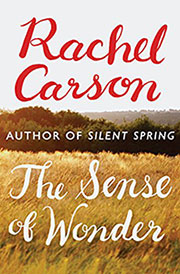 In her book A Sense of Wonder, Rachel Carson wrote:
In her book A Sense of Wonder, Rachel Carson wrote:
If I had influence with the good fairy who is supposed to preside over the christening of all children, I should ask that her gift to each child in the world be a sense of wonder so indestructible that it would last throughout life, as an unfailing antidote against the boredom and disenchantments of later years, the sterile preoccupation with things that are artificial, the alienation from the sources of our strength.
To a young child or a listening heart everything is a wonder. How do bees find the right flowers for nectar and pollen? How do birds find their hidden migration highways in the sky? How does a seed turn into a tree?
This month we want to write about children’s books that nourish that sense of wonder and get kids outside.
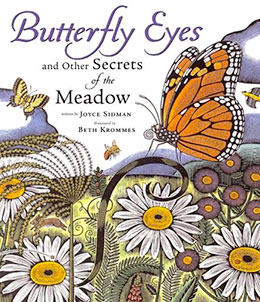 Butterfly Eyes and Other Secrets of the Meadow by Joyce Sidman, illustrated by Beth Krommes, is itself a wonder of poetry and art. Two poems per double page spread, each of which ends with the question “What am I?” alternate with a double page spread that answers the questions (although the art gives plenty of clues) and gives more information about the relationship between the two subjects of the previous poems. So spread with a poem about sleeping rabbits and one about a hunting fox is followed by a spread explaining how foxes use their incredible hearing to hunt rabbits and how baby rabbits hide until they are ready to go out into the meadow on their own. (Their mother visits them only occasionally so as not to reveal their nest to predators.) This book is a wonderful reminder to all of us to look closely, to pay attention.
Butterfly Eyes and Other Secrets of the Meadow by Joyce Sidman, illustrated by Beth Krommes, is itself a wonder of poetry and art. Two poems per double page spread, each of which ends with the question “What am I?” alternate with a double page spread that answers the questions (although the art gives plenty of clues) and gives more information about the relationship between the two subjects of the previous poems. So spread with a poem about sleeping rabbits and one about a hunting fox is followed by a spread explaining how foxes use their incredible hearing to hunt rabbits and how baby rabbits hide until they are ready to go out into the meadow on their own. (Their mother visits them only occasionally so as not to reveal their nest to predators.) This book is a wonderful reminder to all of us to look closely, to pay attention.
We both love the poem in which the owl is apologizing for his sharp talons, keen eyes, silent wings, and hooked beak, not as one first thinks, because he is sorry to be a predator.
I’m so sorry. For you, that is.
All this works out quite well for me.
The combination of question poems, explanation of the interconnections of species, and vivid, brilliant art reveal the complexity of the meadow and make us want to venture more often into the meadow, where a web of life as intricate as a spider’s wed exists.
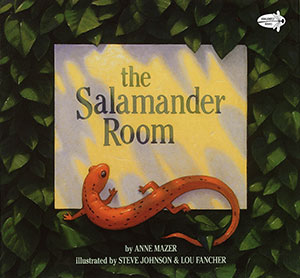 The Salamander Room by Anne Mazer, illustrated by Steve Johnson, tells how a little boy Brian finds a salamander in the woods and takes him home, where his mother asks him, “Where will he [the salamander] sleep?”
The Salamander Room by Anne Mazer, illustrated by Steve Johnson, tells how a little boy Brian finds a salamander in the woods and takes him home, where his mother asks him, “Where will he [the salamander] sleep?”
Brian answers,
“I will make him a salamander bed to sleep in. I will cover him with leaves that are fresh and green, and bring moss that looks like little stars to be a pillow for his head. I will bring crickets to sing him to sleep and bullfrogs to tell him good-night stories.”
To each of his mother’s questions — Where will he play? What will he eat? — Brian tells how he will transform his room to make it a home for a salamander and friends. Brian’s explanations and the luminous art turn his room into a place for birds and bullfrogs with trees and ponds until he has lifted off the ceiling of his room. To the last question, “And you — where will you sleep?” Brian answers,
“I will sleep on a bed under the stars, with the moon shining through the green leaves of the trees; owls will hoot and crickets will sing; and next to me, on the boulder with its head resting on soft moss, the salamander will sleep.”
He answers.
Who wouldn’t want to sleep in a salamander room? Magical.
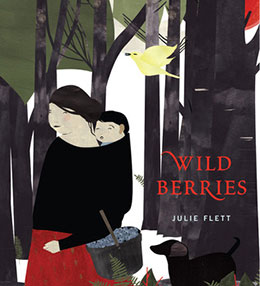 Wild Berries, written and illustrated by Julie Flett, one of our favorite authors and illustrators, tell how Grandma used to carry Clarence to pick wild berries and sing to him, but now he is big enough to carry his own bucket, sing with Grandma, and pick berries with her tup tup. [Flett so skillfully captures the sound of berries dropping into a bucket.] While they pick he and grandma eat berries until their lips turn purple and Clarence observes the world around him. An ant crawls up his leg, a spider spins a web, a fox sneaks past. He leaves berries on a leaf for the birds and other animals who say nanaskomowak, Cree for thank you.
Wild Berries, written and illustrated by Julie Flett, one of our favorite authors and illustrators, tell how Grandma used to carry Clarence to pick wild berries and sing to him, but now he is big enough to carry his own bucket, sing with Grandma, and pick berries with her tup tup. [Flett so skillfully captures the sound of berries dropping into a bucket.] While they pick he and grandma eat berries until their lips turn purple and Clarence observes the world around him. An ant crawls up his leg, a spider spins a web, a fox sneaks past. He leaves berries on a leaf for the birds and other animals who say nanaskomowak, Cree for thank you.
Each spread of this lovely book includes Cree words printed in red in the same size font below the English words in black. An endnote explains that this is Swampy Cree, one of several dialects, and includes a pronunciation guide. A recipe for wild blueberry jam makes us wish it were earlier in the summer so we could go find some tart wild berries, pick them, and make jam.
Flett’s palette of greens, browns, blues, and soft yellows is punctuated by red on each page: grandma’s red skirt, a red sun, red fox, red butterflies, flowers, and red breasted birds that sing (nikamo) in the clearing.
Here again, we find the wonder of the natural world. And the joy of looking closely.
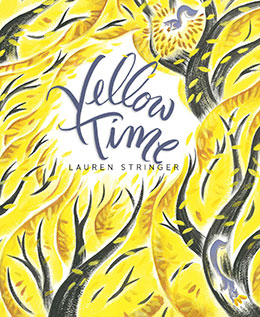 Lauren Stringer’s Yellow Time, illustrated by the author, is another luminous book about fall and the turning of leaves. The text describes yellow time when the leaves all turn. It begins,
Lauren Stringer’s Yellow Time, illustrated by the author, is another luminous book about fall and the turning of leaves. The text describes yellow time when the leaves all turn. It begins,
The squirrels are too busy to notice.
And the geese have already gone.
Other birds have left too,
But not the crows.
Crows love yellow time.
So do the children, whom the art shows in increasing numbers coming out to play, smelling the yellow time air “like wet mud and dry grass with a sprinkle of sugar,” running in the swirling leaves, dancing in a whirlwind of yellow.
Everywhere fills
with yellow.
A symphony
of yellow.
As the leaves all fall and the book winds down, the children return home, one by one with
bouquets of yellow
to press in thick books
to remember…
what a lovely yellow time it was.
With lines and colors that swirl and with spare, poetic text, Stringer’s book is a symphony to fall and the joy children take in leaves falling. And who is ever too old not to enjoy the swish of walking through leaves?
Rabbits, owls, salamanders, berries, foxes, leaves, crows, earth, trees, wind, sky: we are all related.
And isn’t that a wonder?

Jacqueline, I took SNOWFLAKE BENTLEY to the food shelf for their lobby and to be taken home by a child or parent.
Phyllis, I couldn’t part with any of your books. I am slowly, painstakingly, giving away some of the books I collected over the years. I think anyone who reaches the age of 88 years should probably do this…